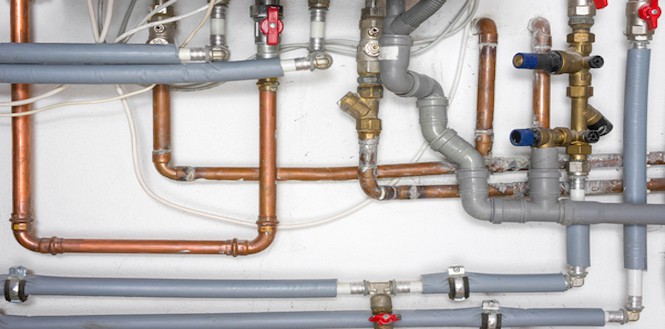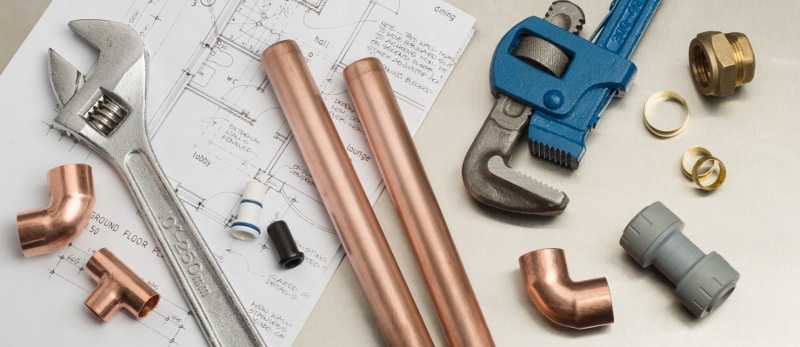The Basics to Your Home's Plumbing System Anatomy
The Basics to Your Home's Plumbing System Anatomy
Blog Article
How do you feel about Plumbing Installation 101: All You Need to Know?

Understanding just how your home's plumbing system works is important for each property owner. From supplying tidy water for alcohol consumption, food preparation, and bathing to safely removing wastewater, a properly maintained plumbing system is important for your household's wellness and comfort. In this detailed guide, we'll discover the elaborate network that comprises your home's plumbing and offer pointers on maintenance, upgrades, and managing usual concerns.
Intro
Your home's pipes system is greater than just a network of pipes; it's a complicated system that ensures you have accessibility to tidy water and effective wastewater removal. Recognizing its elements and how they work together can help you stop expensive fixings and ensure whatever runs smoothly.
Fundamental Components of a Pipes System
Pipelines and Tubing
At the heart of your pipes system are the pipelines and tubing that carry water throughout your home. These can be made of different materials such as copper, PVC, or PEX, each with its advantages in regards to toughness and cost-effectiveness.
Components: Sinks, Toilets, Showers, and so on.
Components like sinks, commodes, showers, and tubs are where water is made use of in your home. Comprehending how these components link to the pipes system assists in diagnosing problems and planning upgrades.
Shutoffs and Shut-off Points
Shutoffs manage the circulation of water in your pipes system. Shut-off valves are critical during emergencies or when you need to make repairs, permitting you to separate parts of the system without interrupting water circulation to the entire residence.
Water System System
Key Water Line
The main water line links your home to the municipal water system or a private well. It's where water enters your home and is distributed to numerous components.
Water Meter and Stress Regulator
The water meter procedures your water use, while a pressure regulatory authority ensures that water moves at a safe stress throughout your home's pipes system, preventing damage to pipelines and fixtures.
Cold Water vs. Warm water Lines
Comprehending the difference in between cold water lines, which supply water directly from the primary, and warm water lines, which bring warmed water from the hot water heater, helps in fixing and preparing for upgrades.
Water drainage System
Drain Piping and Traps
Drain pipelines carry wastewater away from sinks, showers, and bathrooms to the sewage system or septic tank. Traps protect against sewer gases from entering your home and also trap particles that can create clogs.
Ventilation Pipelines
Air flow pipelines permit air right into the drainage system, preventing suction that might reduce water drainage and cause traps to empty. Proper ventilation is crucial for keeping the integrity of your plumbing system.
Importance of Proper Drainage
Guaranteeing correct water drainage protects against back-ups and water damages. Regularly cleaning drains pipes and maintaining traps can prevent costly repairs and extend the life of your plumbing system.
Water Heating System
Types of Water Heaters
Water heaters can be tankless or traditional tank-style. Tankless heaters warmth water as needed, while containers keep heated water for prompt usage.
Exactly How Water Heaters Link to the Plumbing System
Recognizing how water heaters connect to both the cold water supply and hot water circulation lines assists in diagnosing issues like not enough warm water or leaks.
Maintenance Tips for Water Heaters
On a regular basis purging your hot water heater to get rid of sediment, inspecting the temperature settings, and evaluating for leakages can prolong its life expectancy and improve power performance.
Typical Plumbing Concerns
Leaks and Their Causes
Leakages can occur due to maturing pipes, loosened installations, or high water stress. Attending to leaks without delay stops water damage and mold and mildew development.
Clogs and Blockages
Obstructions in drains pipes and toilets are usually brought on by flushing non-flushable items or a build-up of grease and hair. Making use of drain displays and bearing in mind what goes down your drains pipes can prevent obstructions.
Indications of Pipes Issues to Expect
Low water stress, slow drains pipes, foul odors, or uncommonly high water costs are indications of possible plumbing troubles that ought to be resolved quickly.
Pipes Maintenance Tips
Routine Inspections and Checks
Schedule yearly plumbing assessments to capture issues early. Seek signs of leaks, rust, or mineral build-up in faucets and showerheads.
Do It Yourself Upkeep Tasks
Easy jobs like cleaning tap aerators, checking for bathroom leakages using dye tablet computers, or insulating subjected pipelines in cold environments can prevent significant plumbing problems.
When to Call a Professional Plumbing Professional
Know when a plumbing problem calls for professional knowledge. Trying complex repairs without proper understanding can cause even more damages and greater fixing costs.
Upgrading Your Plumbing System
Factors for Updating
Updating to water-efficient fixtures or replacing old pipes can enhance water top quality, lower water bills, and enhance the value of your home.
Modern Plumbing Technologies and Their Benefits
Check out innovations like clever leakage detectors, water-saving commodes, and energy-efficient water heaters that can save money and decrease environmental effect.
Expense Factors To Consider and ROI
Calculate the upfront costs versus lasting financial savings when taking into consideration pipes upgrades. Lots of upgrades pay for themselves with decreased utility bills and less fixings.
Ecological Effect and Preservation
Water-Saving Fixtures and Devices
Mounting low-flow faucets, showerheads, and toilets can significantly reduce water use without giving up efficiency.
Tips for Decreasing Water Usage
Straightforward behaviors like taking care of leaks without delay, taking much shorter showers, and running full lots of washing and meals can save water and lower your utility bills.
Eco-Friendly Pipes Options
Take into consideration sustainable plumbing products like bamboo for floor covering, which is durable and eco-friendly, or recycled glass for kitchen counters.
Emergency situation Preparedness
Steps to Take Throughout a Plumbing Emergency situation
Know where your shut-off valves lie and how to turn off the water supply in case of a burst pipeline or significant leak.
Value of Having Emergency Get In Touches With Helpful
Maintain contact info for neighborhood plumbings or emergency situation solutions readily available for fast action during a pipes situation.
Do It Yourself Emergency Situation Fixes (When Applicable).
Short-lived solutions like using duct tape to patch a leaking pipe or putting a container under a dripping faucet can reduce damages until an expert plumbing shows up.
Conclusion.
Recognizing the composition of your home's pipes system equips you to keep it successfully, saving money and time on repair services. By following normal maintenance regimens and remaining informed regarding modern pipes modern technologies, you can ensure your pipes system runs efficiently for several years to come.
HOW YOUR PLUMBING SYSTEM WORKS
Which Pipes Do What?
Blue lines = fresh water supply entering the building
Red lines = hot water supply entering the building
Grey lines = pipes carrying waste away from the building and venting pipes carrying gases away from the building (through the roof)
YOUR MAIN PLUMBING SYSTEMS
There are two main plumbing systems that support your home s basic plumbing needs one that brings clean water into your home, and one that sends dirty water away from your home. Connected to the toilet, bath, shower, and other faucets in your home, these two systems keep your water flowing in the right directions.
ACCESSING FRESH WATER
Fresh and clean water is brought into your home through the main water supply line . Filtered through one pipe, this water is pressured to flow into the various fixtures in your home at any given time.
This water can be sourced from a well located on your property, a pond or river (mostly cottages), or, as in most cases, from the city s municipal water treatment centre. However, it is important to note that water that is untreated, such as the water siphoned from ponds or rivers, may not be safe to drink. Personal water supplies always need to be treated for hardness and contaminants before consumed.
MUNICIPAL WATER SUPPLIES
Improve taste and odour
Remove sediment
Eliminate hardness
Reduce chlorine
COLD WATER SUPPLY VS. HOT WATER SUPPLY
Cold water flows into your home or building through the service line, which then distributes hot or cold water to your fixtures. This line is most commonly run through a central column that runs floor to floor. Hot water runs in short and straight pipes as the longer the pipeline, the more heat that will be lost in the transfer. Having shorter pipes also allows residents to access hot water more quickly.
WASTE WATER SYSTEM
Your wastewater system is divided into two parts pipes that send wastewater away from your home and venting pipes that send sewer gas away from your home. Sewage water travels through pipes that flush the water and waste towards local sewers that are operated and managed by your city or town. Most sewer systems rely on gravity to move the wastewater to where it needs to go.
The further away from your toilet or sink, the larger wastewater pipes become. This allows for waste to be disposed of from various parts of your home or business at once without pipe blockages. The angle and flow of these pipes are also essential for keeping your waste pipes clear of build up.
https://harrisplumbing.ca/how-your-home-plumbing-system-works/

HOW YOUR PLUMBING SYSTEM WORKS
Which Pipes Do What?
YOUR MAIN PLUMBING SYSTEMS
There are two main plumbing systems that support your home s basic plumbing needs one that brings clean water into your home, and one that sends dirty water away from your home. Connected to the toilet, bath, shower, and other faucets in your home, these two systems keep your water flowing in the right directions.
ACCESSING FRESH WATER
Fresh and clean water is brought into your home through the main water supply line . Filtered through one pipe, this water is pressured to flow into the various fixtures in your home at any given time.
This water can be sourced from a well located on your property, a pond or river (mostly cottages), or, as in most cases, from the city s municipal water treatment centre. However, it is important to note that water that is untreated, such as the water siphoned from ponds or rivers, may not be safe to drink. Personal water supplies always need to be treated for hardness and contaminants before consumed.
MUNICIPAL WATER SUPPLIES
COLD WATER SUPPLY VS. HOT WATER SUPPLY
Cold water flows into your home or building through the service line, which then distributes hot or cold water to your fixtures. This line is most commonly run through a central column that runs floor to floor. Hot water runs in short and straight pipes as the longer the pipeline, the more heat that will be lost in the transfer. Having shorter pipes also allows residents to access hot water more quickly.
WASTE WATER SYSTEM
Your wastewater system is divided into two parts pipes that send wastewater away from your home and venting pipes that send sewer gas away from your home. Sewage water travels through pipes that flush the water and waste towards local sewers that are operated and managed by your city or town. Most sewer systems rely on gravity to move the wastewater to where it needs to go.
The further away from your toilet or sink, the larger wastewater pipes become. This allows for waste to be disposed of from various parts of your home or business at once without pipe blockages. The angle and flow of these pipes are also essential for keeping your waste pipes clear of build up.
https://harrisplumbing.ca/how-your-home-plumbing-system-works/
I discovered that blog posting about Exploring Your Homes Plumbing Anatomy when doing a lookup on the search engines. Liked our blog entry? Please share it. Help somebody else locate it. Thank-you for going through it.
Call Today Report this page